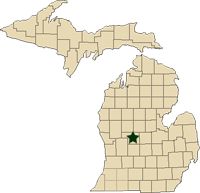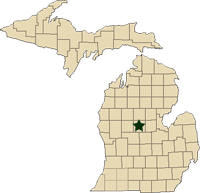Regional reports on Michigan field crops – September 22, 2011
MSU Extension educators’ pest and field crop updates for Michigan.
This week’s regional reports:
- West Central Michigan – Fred Springborn
- Central Michigan – Paul Gross
West Central Michigan – Fred Springborn, Michigan State University Extension
|
Weather
Scattered light frost on Thursday, September 15, and Friday, September 16, was observed in Montcalm. Damage is predominantly in low lying areas. High temperatures have been in the 60s to low 70s. Rainfall has been sparse until Monday, September 19, when much of the area received 0.5 to 0.75 of an inch
Crop reports
Soybeans are turning; a few fields have dropped their leaves. Frost damage was primarily in low lying areas. Much of the crop was mature enough to not sustain significant injury from frost.
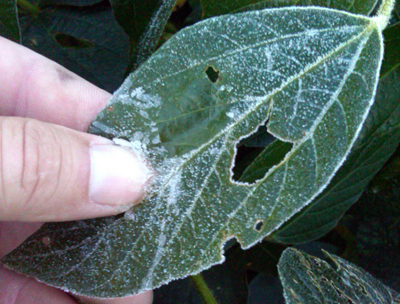
Frost on soybean leaf, September 15.
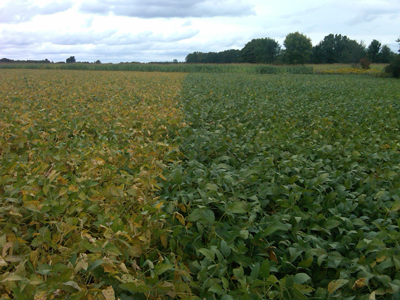
Taken September 14, the soybeans on the left are group 1.9 and soybeans
on the right are group 2.2. Both groups were planted on the same day in
mid- to late May.
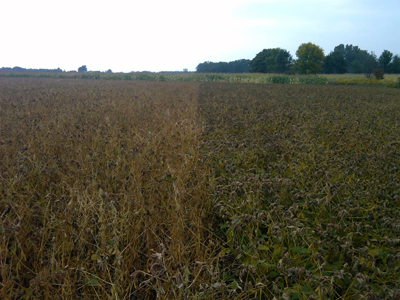
Taken September 21, six days after frost. While the top leaves were
damaged by frost on the group of 2.2 soybeans (right), yield loss
should be minor in this field.
Dry bean harvest is two-thirds complete in Montcalm with only a few fields immature enough to be injured by frost. Yields are average and quality is generally good.
The majority of corn has reached hard dent and much of it has black layer. As with soybeans, late planted corn was injured by frost in low lying areas. Silage harvest is nearing completion on many dairy farms in the region.
Wheat is being planted as dry bean and potato harvest progresses.
Central Michigan – Paul Gross, Michigan State University Extension
|
Weather
Temperatures dipped just below freezing last week, causing crop growth to end in many low-lying areas. Late planted soybeans will be most affected. Rainfall early in the week left as much as 1 inch in the northern parts of the region with lesser amounts as you move south. Growing degree day totals from March 1 are about 2600.
When the book is closed on the 2011 growing season, the statistics will show about average temperatures and rainfall. However, this year has been filled with challenges from start to finish. With the nearly ideal growing condition of 2010 still fresh in our memory, then this year’s problems, it is a reminder of the risks farmers take every year.
Commodity reports
May planted corn is black layered, but corn planted in June still needs a little more time. Corn silage harvest is wrapping up with most reporting good yields and quality. There is a lot of discussion on how and why the corn is drying from top down as well as from bottom up this year. There are several theories that include disease and stress during the growing season. If you suspect disease, it would be a good idea to have samples tested to properly identify the problem. This time of year is a great time to attend plot tours and field days to get a look at some of the new varieties and how they look compared to the varieties on your farm.
The soybean crop is progressing with some later planted fields damaged by frost. It is too early to determine extent of the yield loss. Early planted fields will be ready harvest late next week if the weather cooperates. Most farmers are optimistic on the yield potential
Wheat planting is just getting underway on summer fallowed fields. Most wheat is planted after soybeans, so planting will follow bean harvest. Farmers are advised to manage perennial weeds before planting.
Dry bean harvest is just getting underway. This is a little later than normal due to later planting. Some early reports are that yields have been a little better than expected. Farmers are cautioned that if you are killing vines with herbicides to remember pre-harvest intervals.
Harvest of fourth cutting alfalfa will resume after the crop goes into dormancy. Many are reporting very good regrowth. New seeding is doing very well.



 Print
Print Email
Email